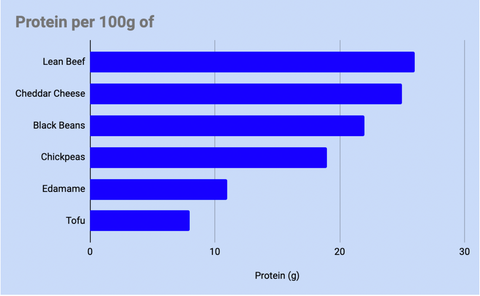YOU MADE IT past the headline, which means you’re at least curious about life without animal protein. You’re making big moves!
I went down this road last spring for environmental reasons. (If you want to learn more, my climate-focused newsletter, one5c, skips the doom and gloom and instead outlines easy steps regular people can take to help preserve and even renew our planet. Subscribe here. Follow one5c on Instagram and Twitter.) But I ended up with diagnosed protein deficiency and symptoms that indicated I wasn’t getting enough vitamin B12 or iron.
So if you’re going to cut meat out of your diet, you should do so without becoming a malnourished mealtime grump. This is super important: If you don’t enjoy your diet, you’re not going to stick with it. So how do you enjoy a meatless diet? Let’s start with the basics.
“There’s a fundamental difference between animal cells and plant cells,” says cookbook author J. Kenji López-Alt. “Animal cells are designed to be elastic and stretch, because animals move. And so muscle has this chew to it.” (I could murder a steak right now.) “Vegetables, on the other hand, are rigid. Plant cells don’t have that same kind of chew,” he says. “They can be crunchy or soft, but they don’t stretch.” I ate a mushroom-and-cabbage thing for lunch. It was soft.
My meat-thirsty inner monologue is not helpful—to myself or to you. López-Alt would concur. “Just get it out of your head that a meal needs to be meat or have that particular texture,” López-Alt says. That may sound simplistic, but think of this as an opportunity to expand your food world. “You can turn to any of the diverse vegetarian cuisines and cultures that have full, satisfying, healthy meals,” says López-Alt. “Look to India, or parts of South America, or Asia.”
If you’re a newly minted vegetarian or a vegan who loves the taste and texture of meat, though, “now is the best time to be alive,” says López-Alt, because “companies like Impossible and Beyond Meat already make good products, and they’re only getting better.”
I’m with him on this. I’ve found almost no downside to substituting fake meat for ground beef in most recipes, and an Impossible burger is almost always better than a fast-food burger.
In fact, let me turn the heat up a little: A hamburger is more about the bun than the meat. Nobody orders Salisbury steak, and ground beef is just the best way to serve bad cuts. For years, we tolerated turkey burgers, and it wasn’t because dry, grey patties are so appetizing.
López-Alt won’t go as far as I do, but he’s in the same zip code. “When you’re talking about a hamburger, which is a patty of something with some toppings and a bun, I think the flavor is the least important part when you’re trying to make substitutions,” he says. “Really the texture is the important thing.” Part of that texture is whatever you’re using as meat;” and you can crisp up the fake stuff very well.
But the other elements of a burger are more than mere accessories. A good bun is a purpose-baked little loaf of bread, and its springy deliciousness is not to be overshadowed by some three-ingredient protein puck. Similarly, the flavor brought by the crisp of a pickle, the smooth melted cheese, and the bright sauce provide contrast to the hot, savory patty in an orchestra of flavor that shouts: we are each our own instrument! The little brown thing in the middle is percussion at best.
No disrespect to the Original Griller, a freezer staple at the Brown house, but non-meat patties have come a looooong way. “It’s the juiciness factor,” says López-Alt. “When you bite into a steak or a piece of chicken, there are sheaths of proteins that are full of juices. And those juices stay in place until you bite into them. That feeling of chewing something and juice or flavor coming out is the essential eating experience of meat.” The new crop of imitation meats have identified and utilized plant proteins that can behave this way and come very close to that sensation. They aren’t as good as really good beef, but you’re not using a Wagyu porterhouse for Taco Tuesday.
The other experiential difference is in how animal fats feel in your mouth, and this is something the imitators don’t do as well. “Most animal fats are highly saturated, which means at body temperature they are essentially still solid,” says López-Alt. “As you cook them, they get softer and eventually liquify. But most plant-based fats are liquid at room temperature.”
This is a huge challenge for beef substitutes, and it’s complicated by the fact that a given piece of meat will have several different kinds of fat in it, many of which melt at different temperatures. So when you bite into a steak, you’re tasting some fats that are melted and some that are still solid. “The way the fats coat your mouth and deliver all those different fat-soluble flavors is a very different experience,” says López-Alt.
Some plant-based fats are solid at room temperature, though, and they have the potential to deliver the same sort of substantial, satisfying mouthfeel. Palm oil and coconut oil are the two most prevalent examples. Let’s just agree to skip palm oil, though; it’s a major driver of deforestation worldwide. Coconut fat, on the other hand, is great to have in your pantry. There are tons of Thai curries and Indian dals that use coconut milk.
Taking Care of Your Body
If you make the switch, the big challenge is making sure you adjust your diet to compensate for all the nutrients you’re no longer getting from the animal kingdom. I called Catherine Perez, a registered dietician with a master’s degree in human nutrition. I found her on Instagram, while trying to figure out how to cook more than a big salad or my trademark “chickpeas with tomato and whatever leaves I find in the fridge.”
Vegan instagram is frickin’ awesome. My two favorite recipe inspo accounts are a German high school student (!!) named Maya and a Taiwanese chef (and UC Berkeley biochemistry student) named George Lee. Between the two of them, plus some aggregators, I’ve been tearing it up in Flavor Town. Nutrition wasn’t as easy for me.
Perez recommends making a plan. “Tracking can be really helpful,” she says. She suggests logging what you eat before and after you cut meat out of your diet, so you can see what changes.
I use MyFitnessPal to track my meals and snacks. It’s fine. I found it particularly helpful for getting a baseline understanding of how my go-to foods contributed to my protein and caloric kitty. Casey Johnston over at She’s a Beast recommends a new app called MacroFactor. Casey is a certified personal trainer, and she’s an experienced consumer-tech journalist as well. So if you’re going to track your diet as part of a strength-training program, I’d check that out.
As you compare, the first thing you’ll probably notice is that you’re not getting enough calories. “This is pretty typical,” says Perez. “Plant-based foods tend to be lower in calories and have a lot more fiber,” she says. “They fill us up a lot easier compared to traditional American fare.” So you could come out of a midday vegetable crime scene feeling satisfied, but you might not be that nourished. “Try smaller meals throughout the day,” says Perez. That will help spread the fiber out, and you can eat more without being uncomfortably full.
Perez also advises that you pay attention to protein. “Probably the biggest thing I see is people completely removing the meat, but not replacing it appropriately,” she says. “This can lead to protein deficiency.” (????)
And she cautions, “protein needs can be different depending on your situation, whether you’re exercising a lot or dealing with an injury or any number of factors.”
Again, it’s never a bad idea to talk to a pro.
Once you get past calories and protein, you need to watch out for a few nutrients that aren’t as plentiful in an all-plant diet:
- Calcium – If you plan to keep dairy on your menu, you’ll probably be good on calcium. If not, you can get it from dark leafy greens, almonds, sesame seeds (including tahini), and tofu that lists calcium citrate as an ingredient.
- Zinc – Time to fire up your seed game. Pumpkin seeds and sunflower seeds are good sources, and they’re also great on salads. Dark leafy greens have some zinc as well.
- Magnesium – Pumpkin seeds and dark leafy greens again. It always comes back to dark leafy greens.
- Iron – Black beans, chickpeas, red kidney beans. Many whole grains are good sources of iron, as are dried fruits and nuts (pistachios, the iron-kings). Also—surprise!—dark leafy greens. Some rice is enriched with iron, so check your labels. Perez has an important tip here, though: Iron found outside of the animal kingdom is non-heme iron, and you can increase how well your body absorbs it by adding some vitamin C. A small squeeze of citrus makes a big difference.
- B12 – The easiest way to get B12 (aside from meat and dairy), says Perez, is with a supplement, but you can also find it in fortified foods like soy milk and breakfast cereals. Here is the justification you’ve been waiting for to keep Lucky Charms in the cupboard: 20-percent of your recommended daily B12 intake from a tiny bowl of joy. They’re not vegan though—gelatin in those magically delicious marshmallows.
Perez has a few easy tricks for staying healthy, too. She kicks the day off over a latte made with fortified plant milk, which delivers a quick hit of protein and other nutrients like B12. And she tries to eat these five things every day:
- Flax seeds
- Oats
- Beans
- Dark leafy greens
- Some kind of probiotic food like miso, kimchi, or sauerkraut
She recommends keeping that list stuck to your fridge door. If you eat everything on it every day, you’ll probably be good to go.
Until then, see how much meat you can leave at the butcher’s. Celebrate every all-plant meal as a victory and chew-carve little trophies out of carrots. Then eat them with peanut butter. Try some new veggies and pour yourself a grownup-size bowl of kids’ cereal. What you eat can make a serious impact on the world, but that doesn’t mean meals shouldn’t be fun. If you ever get stumped at dinnertime, remember: Most beer is vegan, and it’s calorie-dense. (Please do not take my nutritional advice.)
This content is created and maintained by a third party, and imported onto this page to help users provide their email addresses. You may be able to find more information about this and similar content at piano.io





Comments are closed.